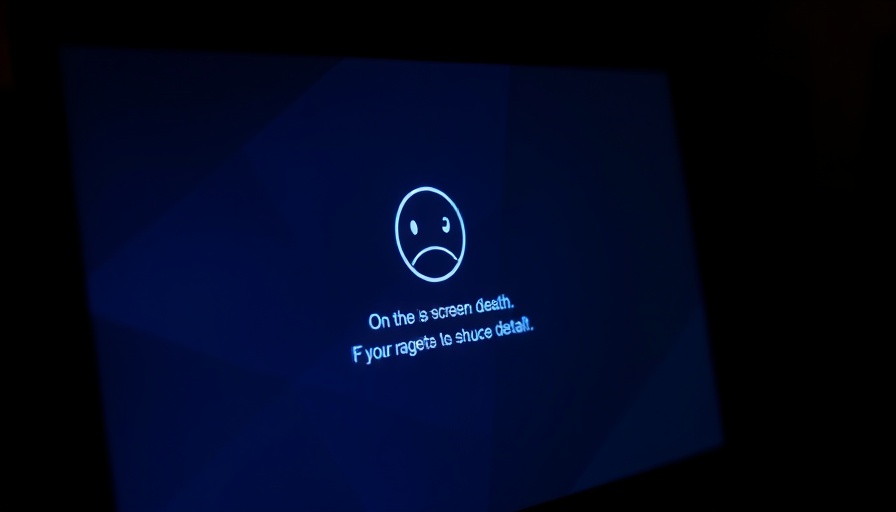
Goodbye to the BSOD: A Farewell to an Icon
For many tech enthusiasts and everyday users alike, the Blue Screen of Death (BSOD) has been a rite of passage in the Windows computing experience. This familiar yet dreaded sight has encapsulated moments of frustration for nearly four decades, serving as a reminder of system failures and recovery efforts. As Microsoft prepares to retire the BSOD, we reflect on its origins, evolution, and the mixed emotions that linger as it bids farewell.
Origins of the BSOD: A Journey Through Time
The story of the BSOD isn't just about a color palette or user interface design; it's about how technology has evolved. Emerging with Windows NT in 1993, the blue screen became a symbol of critical errors. But it didn't start as a harbinger of doom. In fact, early Windows error messages were much more benign. Before the BSOD, users encountered various shades of system messages, often accompanied by confusing white text on blue backgrounds.
Interestingly, the initial design choices, such as the blue background, were made by Microsoft architect John Vert because they matched his workstation preferences. They seem almost whimsical today, yet these decisions cemented a cultural icon within the tech community.
The Iconic Color Change: From Blue to Black
Microsoft's announcement to replace the BSOD with a black screen resonates deeply within the tech community. Many users grow nostalgic as they contemplate the emotional landscape that the BSOD occupied—panic, dread, and a hint of resentment. The transition to a minimalist black screen—merely stating "Your device ran into a problem and needs to restart"—not only reflects a design shift but also signifies a cultural evolution in how error handling is approached.
This change has been met with mixed reactions. Some users welcome the new simplicity, asserting that the previously verbose messages were often unhelpful. Others mourn the loss of the more recognizable blue screen, viewing it almost as a badge of honor for experiencing the complexities of computing over the years.
Historical Context and Background of Computing Errors
To fully appreciate the significance of the BSOD, one must also recognize the historical context of computer errors. From the '70s onwards, programmers have strived to create smoother user experiences. Yet, errors have always been an inevitable part of computing. The BSOD became a point of connection for users; everyone who spent time on Windows had some tale of a crash—the ultimate shared experience. As systems become smarter, the question arises: will future users have similar connections with their error messages?
A New Era: Predicting the Future of Error Screens
The retirement of the BSOD raises intriguing questions about the future of user interfaces. As systems increasingly automate error reporting and diagnosis, will users feel less of a connection to their devices? Or will future interfaces evolve to engage users in new, non-frustrating ways, encouraging interaction even amidst failure?
Emerging technologies like AI can allow for real-time assistance during failures, something we have not seen in previous generations. This paradigm shift could lead to more effective resolutions and less emotional distress surrounding system failures.
Reflecting on Shared Experiences: The Community Voice
Ultimately, the BSOD is not merely a technical failure screen, but a communal touchpoint that reflects the emotional journey of its users. Reminiscing about the BSOD opens a dialogue about shared experiences in technology. As users, we’ve all braved those anxiety-inducing moments, waiting for the system to restart and praying our unsaved work is still intact.
This cultural significance extends into various online communities where meme culture and anecdotes thrive, illustrating how the BSOD became both a source of humor and a poignant reminder of the human element intertwined with technological progression.
Conclusion: The Impact of Change on Tech Communities
The phase-out of the BSOD signifies an end to an era that has enveloped users in a spectrum of emotions over the years. While the blue screen may fade into nostalgia, its impact on the tech community remains deeply rooted. As users, we adapt to change, and incorporate the lessons learned into our future interactions.
As we say goodbye to the BSOD, we may also want to ask ourselves: What new stories and connections will emerge in this next chapter of technological advancement? Embracing change is part of our growth as digital citizens. Understanding the evolution of familiar elements, like the BSOD, provides us with key insights into the future of technology and user experiences.
 Add Row
Add Row  Add
Add 




Write A Comment